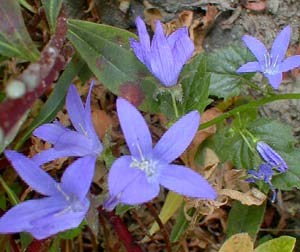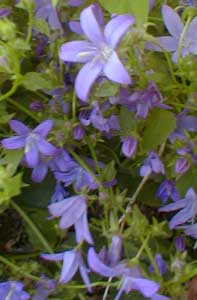
Serbian Bellflower
"Through the blue shadowy valley
I hastened in a dream:
Flower rich the night, flower soft the air,
a blue flower the stream."
-George William ("A. E.") Russell
(1867‚1935)
(1867‚1935)
Campanula poscharskyana, the Serbian Bellflower, native of the northern Balkins, is named for the first botanist to describe the species, Franz Elder von Portenschlag-Ledermayer (1772-1822).
It is a low-growing groundcover about a foot tall, sometimes humping a bit taller. Clumps are divisible in spring. It sometimes self-seeds for further spread.
It spreads easily, but rarely invasively. The wild form often looks unkempt, for it's a creeper but looks like it should be upright clumpers which fell over. When there is a break in the blooming, sheering them back a great deal can improve the appearance, keeping it tidier, while the shearing also induces rebloom. There are many named cultivars & some of these are tidier.
 The numerous cultivars vary from smaller leaves or different shades of flowers including white, or with a more intensely creeping & ground-hugging behavior hence rarely even four inches tall. This one, however, as the wild form, & just about the hardiest of a hardy lot, is maximumly untidy. It will also eradicate anything smaller in its vicinity, so a great weed suppressor, but at the same time one has to be careful to select companion plants that can deal with serbian bellflower's dense creeping foot-tall ground coverage.
The numerous cultivars vary from smaller leaves or different shades of flowers including white, or with a more intensely creeping & ground-hugging behavior hence rarely even four inches tall. This one, however, as the wild form, & just about the hardiest of a hardy lot, is maximumly untidy. It will also eradicate anything smaller in its vicinity, so a great weed suppressor, but at the same time one has to be careful to select companion plants that can deal with serbian bellflower's dense creeping foot-tall ground coverage.In extremely cold zones, Serbian Bellflower dies back in winter, & is root-hardy to minus 40 to minus 30 degrees F. It is not at all heat-tolerant. In such a mild area as Puget Sound, it is semi-evergreen to fully evergreen, & the star-shaped lavender-blue blossoms are around a great long while, from late May or June all the way through September easily, but in our garden still putting on a few flowers as late as November. Sometimes it becomes so flowery it is a pure blue carpet with the leaves nearly hidden, & that's when it looks most glorious, the untidy leaves being hidden.
They like medium wet soils that drain extremely well, in sunny to partially shady locations. Morning sun & afternoon shade is best, though it's quite adaptable. If it is apt to experience a hot summer, more shade is needed. I've noticed that ours has been spreading & blooming best in the direction of the most shade, rather than toward the sun as would be expected of most campanulas. The difference seems to be their disdain for getting overheated, for the flower strength is greatest on the shady side of a clump.
When well-established they're somewhat drought tolerant, but bloom so much better with regular watering. They do well in poor soil, perfect for rock gardens, or placed to spill over rock walls.
Ours were originally growing along a rocky ledge with sharp drainage & indirect watering seeping down from higher ground where rhododendrons & suchlike get watered regularly. They did so well that they overwhelmed several hardy sedums & some reticulated irises, so after three years I dug up this campanula & put it in a harsher location where it can spill out onto the sidewalk, & where it quickly filled inthe ground area underneath a golden eunonymous.
For length of blooming time & adaptability this is a very recommendable species, but I would suggest carefully selecting from amidst named cultivars that have been seen in full maturity.
The wild form might be reserved for tough areas that need a single species for low coverage, but in the mixed garden cultivars can be found that have tidier foliage & shorter stature than the regular wild serbian bellflower. The most restrained cultivar is 'Blue Gown' which is tiny & slow spreading; it may be going too far in the direction of restraint.
A similar species for long-flowering groundcover is the Adriatic Bellflower (Campanula garganica ) which shares many of the strengths of Serbian Bellflower without so much aggression of foliage untidiness.
C. poscharskyana 'Blue Gown'